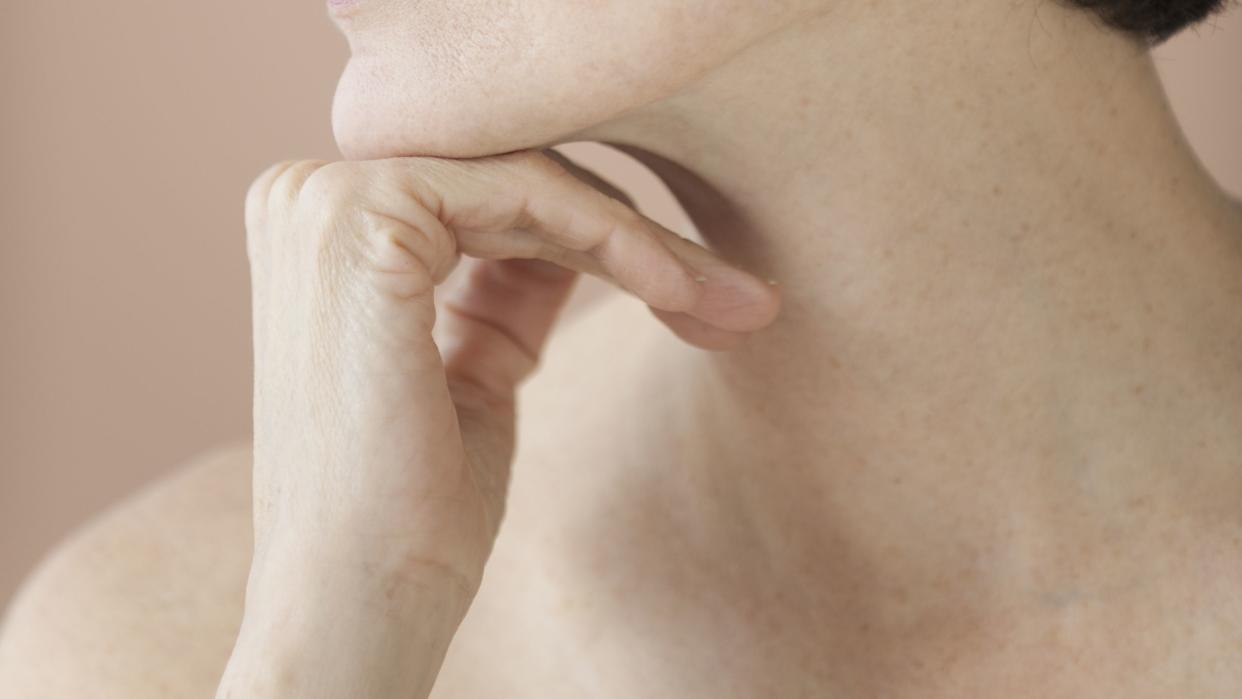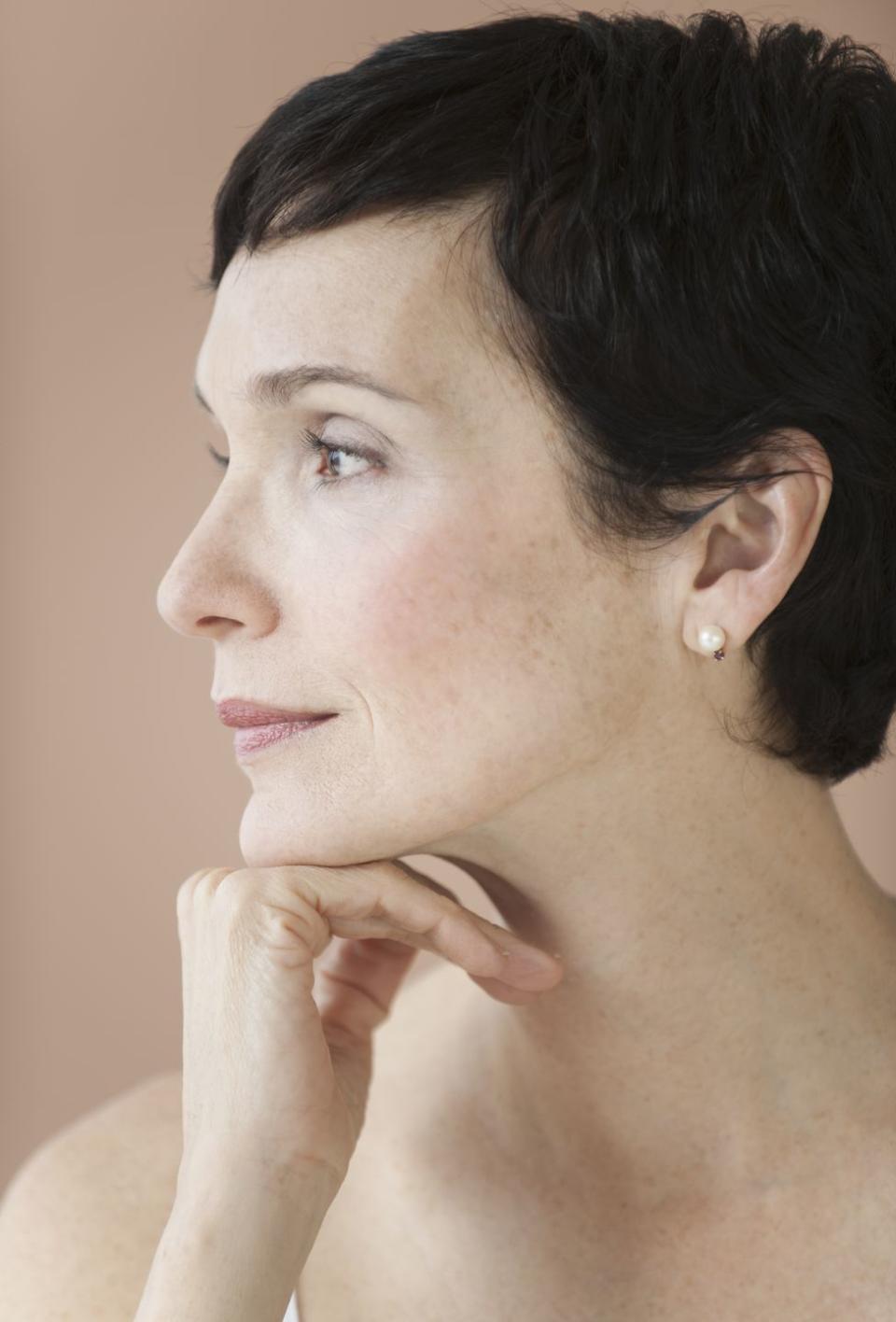This Is What Happens to Your Skin During Menopause

"Hearst Magazines and Yahoo may earn commission or revenue on some items through these links."

There are 34—yes, 34—symptoms of menopause. Some of the biggies are hot flashes, brain fog, and a lagging libido. But it turns out that perimenopause, the four to 10 years leading up to your last period, triggers a host of skin-related concerns as well.
Studies show that estrogen plays a vital role in collagen production, elasticity, thickness, moisture levels, and healthy blood vessels. When it plummets during perimenopause, you start to see the opposite: dryness, dullness, lines and wrinkles, sagging, and even—in a cruel twist—acne. “You can feel part teenager, with breakouts that pop up out of nowhere, and part senior citizen with extreme dryness,” says Doris Day, MD, a dermatologist in New York City. And it can feel like a roller coaster: Estrogen’s downward trajectory—and its effect on your complexion—isn’t gradual or gentle; it’s a series of erratic spikes and crashes that leave you wondering if you aged 10 years overnight. “I can tell that a woman is in perimenopause when she comes to me and says, ‘My skin just fell apart,’” Day says.
That’s why a preemptive approach is ideal. “Perimenopause is slow and insidious, and you’re losing collagen throughout it,” Day says. “You do not want to wait until you’re postmenopausal to combat the unwelcome shifts in your skin.” If you’ve already crossed that bridge, however, don’t sweat it. When caring for her middle-age patients, Miami dermatologist Leslie Baumann, MD, says, “I don’t delineate between perimenopausal, menopausal, or postmenopausal—they all affect the skin similarly.”
It’s a good idea to have your hormone levels checked in your late 30s and early 40s, and discuss hormone replacement therapy (HRT) options with your doctor. “HRT isn’t right for everybody and won’t solve all problems. But you will have a better chance of keeping menopause symptoms at bay and skin healthier while you’re on it,” Day says.
There’s also plenty you can do topically to revitalize your skin. Here’s our guide:
The Issue: Dryness
Dryness is a sign that your skin’s outer protective barrier isn’t up to snuff. As estrogen levels fall, the skin’s epidermis thins, and your sebaceous glands become less active, reducing oil production. Skin becomes drier, and micro tears can form, allowing moisture to escape and irritants and allergens to enter. As a result, skin becomes easily irritated, and you may also see an increase in inflammatory skin conditions. “My eczema got worse during perimenopause,” says Debra Jaliman, MD, a dermatologist in New York City and author of Skin Rules.
The fix: Switch to a mild or gentle cleanser that won’t strip dry skin of its essential oils (ideally a creamy cleanser, not a bubbly one). Then shore up the skin’s barrier with a moisturizer featuring ingredients such as ceramides, shea butter, fatty acids, squalane, glycerin, or hyaluronic acid, which add moisture and help keep it there. Same goes for your body: Use a creamy body wash and a body lotion with those same ingredients. If that’s not enough, smooth on body oil right out of the shower, then layer lotion on top.
The Issue: Dullness
Menopause-induced dryness coupled with the lagging cell turnover that comes with age makes skin look lackluster. “This happens when dead skin cells heap up on the surface—under a microscope, it looks like hills and valleys,” says Baumann. “That topography doesn’t reflect the light so well.” And light reflection is what gives skin a glow.
The fix: Exfoliate dead, dull skin. “Exfoliation is key to keeping skin looking luminous,” says Audrey Kunin, MD, a dermatologist in Santa Rosa Beach, Florida, and founder of DERMAdoctor. Alpha hydroxy acids (AHAs) help slough off dead skin to reveal brighter skin. Glycolic acid, an AHA, is ideal because it’s a humectant, which means it attracts moisture. Use a glycolic-containing serum every other day if your skin can tolerate it.
The Issue: Fine lines and wrinkles
The culprit here is the dwindling collagen supply. You start to lose about 1 percent of your collagen annually in your 30s, but that depletion quickly escalates during postmenopause. “You lose 30 percent of your collagen in the first five years after menopause,” says Day. “So it’s important to keep building collagen while you still can.”
The fix: Two words: topical retinoids. “You don’t need a prescription; these days, the OTC versions are effective and less drying,” Day says. These vitamin A derivatives stimulate collagen production and rev cell turnover, making skin noticeably smoother. Baumann also suggests applying a topical vitamin C serum and taking an oral vitamin C supplement (500 mg twice a day). The antioxidant vitamin is essential for collagen production.
Be sure to follow with a moisturizer. Some formulas made for mature skin may help stimulate your body’s estrogen receptors as well.
The Issue: Acne
Your skin is getting drier, yet you’re still breaking out. How can that be? “As estrogen levels go down, your ratio of female-to-male hormones changes—male hormone levels go up,” says Baumann. And those male hormones, called androgens, are one of the main causes of pimples.
The fix: To clear acne without making skin drier, first turn to a gentle, hydrating alpha hydroxy acid (we like Sofie Pavitt Face Mandelic Clearing Serum). You can use your AHA in the morning and then apply your retinol at night (ease in by applying every other night at first). Because retinol spurs cell turnover, it helps pores stay clear so they’re less likely to clog and form a pimple. Plus, it softens lines at the same time.
The Issue: Sagging
Just as collagen depletes with age, so does its partner elastin—and that’s the stuff that keeps skin taut. “With menopause, I was most surprised by the loss of skin elasticity around my jawline and neck,” says Kunin. According to Baumann, loss of elastin is especially an issue for women of color during menopause. “The pigment in the skin protects their collagen fibers from damage, so their issue is more with skin fragility and sagging than lines and wrinkles,” she says.
The fix: Sunscreen (look for a broad-spectrum SPF 30 or above) and antioxidants (like vitamins C and E) are your BFFs. Research has shown that estrogen protects against photoaging, so preventing sun damage—a major cause of sagginess—is especially important as estrogen wanes. Unfortunately, treating sagging at home is tough. In-office, dermatologists turn to devices like Sofwave, Fotona, and Ultherapy to tighten skin noninvasively. Or, for major results, surgeons offer a full-blown menopause makeover.
You Might Also Like

